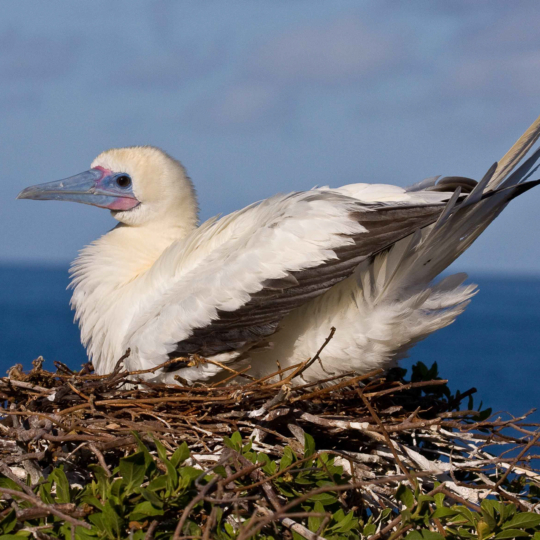Red-footed Booby
Click on an image to enlarge it
Status: IUCN Least Concern
Scientific Name: Sula sula
Hawaiian Name: ʻĀ
Family: Sulidae
Population: 19,000 pairs in the U.S. Pacific Islands. <300,000 total globally.
Feeding: The diet consists primarily of squid and flying fish. Mackeral scads, maury, and anchovy are additional prey items. RFBO typically leave the colony to forage in the early morning and return at nightfall. RFBO are plunge divers and may feed either alone or in mixed-species flocks.
Breeding: Pairs are monogamous and typically breed at their natal colony. Nests are typically built in trees or shrubs, made up of sticks and vegetation. 1 egg is laid per year, and the incubation period is approximately 45 days. Adults will continue feeding chicks for up to 2 months after fledging.
LIFE CYCLE: Breeding begins at 3-4 years of age and the oldest known individual was 22 years old.
Taxonomic Information: There are 3 subspecies of Red-footed boobies: S.s. sula, S.s. rubripes, and S.s. websteri. S.s. rubripes breeds in the central and western Pacific.
Threats and Conservation: Habitat loss, disturbance by development, and invasive predators all pose threats to Red-footed booby colonies. Comprehensive population surveys, like those completed at Kilauea Point National Wildlife Refuge by USGS in 2019, completed comprehensive population surveys of RFBO (as well as Wedge-tailed shearwaters and Red-tailed tropicbirds), help to inform management and also can be used to measure the effectiveness of management actions over time.
PRC and RFBO: 2022-2023 PRC biologists monitored Red-footed booby reproductive success within 3 subsections of the refuge using monthly photographic counts. The new 168-acre predator exclusion fence at Kilauea Point National Wildlife Refuge (KPNWR) will protect this important RFBO breeding site, with a population of 5,049 RFBO individuals as of 2019.
Sources: Felis, J.J., Kelsey, E.C., Adams, J., Stenske, J.G., and White, L.M., 2020, Population estimates for selected breeding seabirds at Kīlauea Point National Wildlife Refuge, Kauaʻi, in 2019: U.S. Geological Survey Data Series 1130, 32 p., https://doi.org/ 10.3133/ ds1130.
U.S. Fish and Wildlife Service. 2005. Regional seabird conservation plan, Pacific Region. U.S. Fish and Wildlife Service, Migratory Birds and Habitat Programs, Pacific Region. Portland, (OR): U.S. Fish and Wildlife Service.




